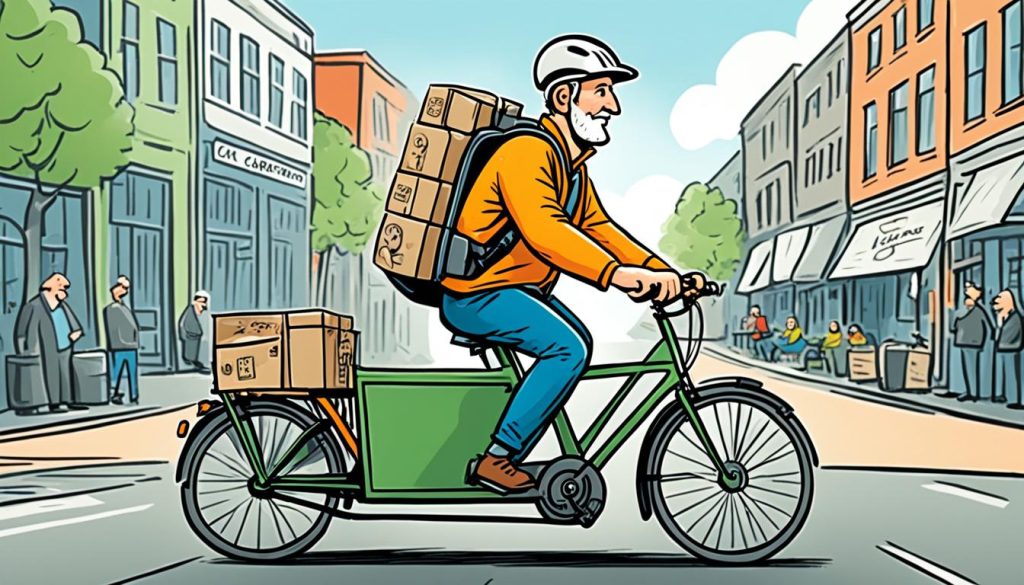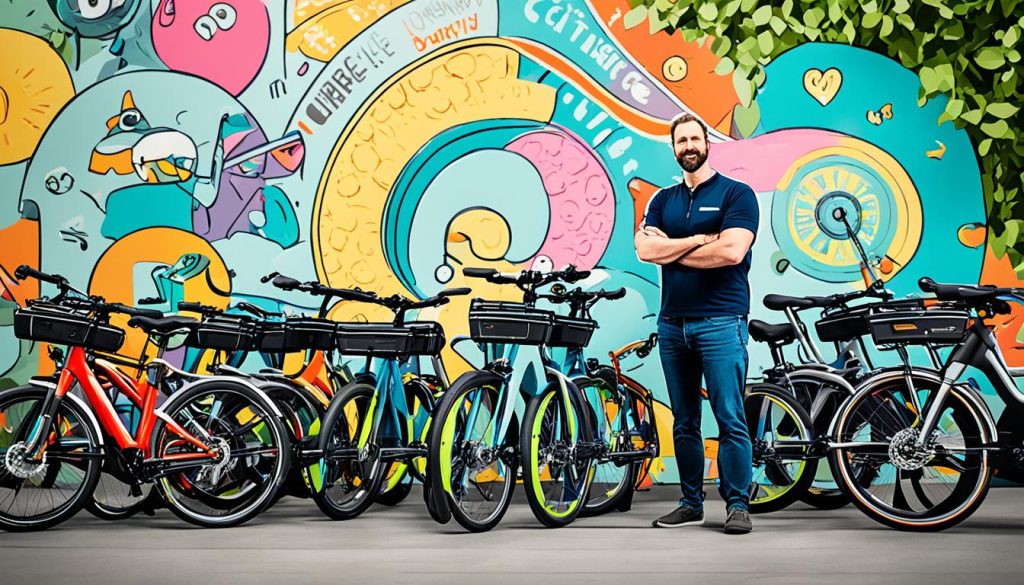If you’re able to ride a regular bike, riding a cargo bike shouldn’t be difficult at all. The steering systems in these bikes are made to be really easy to handle, so you’ll find it pretty straightforward.
In a world where sustainable transport is increasingly paramount, many are turning to two-wheeled solutions. Yet, did you know that the sales of cargo bikes in the UK surged by an impressive 60% in the last year alone? This uptick in popularity brings with it a pressing question: are cargo bikes hard to ride?
For seasoned cyclists, the transition from a normal bike to a cargo bike can seem daunting. The prospect of maneuvering a larger frame on busy streets while carrying everything from groceries to giggling toddlers sounds like a challenge. But, we’re here to navigate through the myths and truthfully, riding a cargo bike is not only a feasible option, it’s easy to ride once you’re accustomed to its unique character.
Cycling enthusiasts need little to no time getting used to the rhythm of a cargo bicycle. Once you’ve got the hang of it, you’ll be weaving through the alleys and lanes with the same ease as any other bicycle. With no license required, it’s an open road for anyone willing to trade four wheels for two—or three, in some cases. And while its speed may be regulated—electric assist cargo bikes are capped at 15.5mph—you’ll be surprised by the places you can go and the loads you can transport, all the while contributing to eco-friendly transport solutions. So, let’s put the pedal to the metal and find out just how approachable these sturdy bikes are.
Key Takeaways
- Switching to a cargo bike is generally straightforward for those with cycling experience.
- Riders typically adapt quickly to the different steering dynamics of cargo bikes.
- Electric assist cargo bikes are ideal for managing heavier loads and maintaining speed within legal limits.
- Cargo bikes often come with advanced braking systems for added safety when carrying significant weight.
- Practice makes perfect—regular use will lead to increased comfort and proficiency on a cargo bike.
Stability and Handling
When we begin cycling on a new type of cargo bike, whether it’s a sleek two-wheeled model or a sturdy tricycle, it’s natural to question the stability and feel of the ride. The handling of these bikes, marked by a low centre of gravity and carefully designed brakes, greatly contributes to a secure and smooth cycling experience. Yet, the transition may bring about a few concerns on how different it feels to control a loaded cargo bike.
Do cargo bikes feel wobbly?
At first ride, the unique dimensions of a cargo bike, whether it be a two-wheeled option or a three-wheel cargo trike, might cause a moment of hesitation as the bike responds differently to our handlebar inputs. But this initial sensation is quickly replaced by confidence as one grows accustomed to the cycle’s design.
How is turning different on a cargo bike?
The art of turning on cargo bikes involves understanding the extended wheelbase and how it affects manoeuvring. Riders quickly learn that a loaded cargo bike may respond slowly, demanding anticipation and gradual movements when navigating turns.
Does the extra weight make cargo bikes hard to control?
Extra weight is a fact of life with cargo cycles – that’s what they’re built for. Efficient design ensures that added mass doesn’t compromise stability. The cargo’s low centre of gravity, coupled with responsive brakes, allows for secure control, even when the bike is heavily laden.
| Type of Bike | Handling Quality | Braking Experience | Stability Factor |
|---|---|---|---|
| Two-Wheeled Cargo Bike | Nimble and Responsive | Quick and Sharp | High with Load Distribution |
| Tricycle/Three-Wheel Cargo Bike | Steady and Controlled | Strong and Dependable | Very High with Low Centre of Gravity |
| Cargo Trike | Consistent and Predictable | Effective at Low Speeds | Maximum due to Three Points of Contact |
Understanding the particularities of cargo bike stability and handling ensures a delightful and secure cycling adventure. As we cycle more, the peculiar feeling of a loaded cargo bike becomes second nature, and our rides become as stable and enjoyable as ever.
Getting the Hang of It
Embarking on the journey of cargo bike riding is an adventure akin to exploring new terrains. It’s exhilarating, a tad challenging, and ultimately rewarding. As we delve into the art of maneuvering these larger than life bicycles, we’ll guide you through the initial stages, sharing the collective wisdom of seasoned cargo bike riders.


Is there a learning curve with cargo bikes?
The leap from a standard bicycle to a cargo bike isn’t vast, but it does require some acclimatization. Adjusting to the additional weight and dimensions means getting used to a different way of balancing and steering. But fear not, it takes some getting used to and with a few peddles, you’ll feel like a natural.
Essential tips for new cargo bike owners
- Start by riding in a quiet area to familiarize yourself with the bike’s response to your movements.
- Mind the wheelbase; longer than usual, it requires wider turns.
- Practise loading your bike with different types of cargo to understand how it affects balance.
- When you pedal, be conscious of pedal clearance, especially around corners.
- Regularly check your brakes – they’re paramount for a heavier ride.
- Book a session with an experience cargo bike rider if possible — they have valuable insights to share.
How long does it take to get comfortable on a cargo bike?
A little patience goes a long way in the cargo bike world. The adjustment period varies, but the consensus among cargo bike riders suggests that within a few weeks of consistent riding, the nuances of cargo cycling become second nature. Embrace the process, relish in the progress, and before you know it, you’ll ride with the same ease and confidence as you do with your regular bike.
| Aspect | Advice |
|---|---|
| Balance | Focus on distributing weight evenly and ensure cargo is secure. |
| Braking | Allow for longer stopping distances, especially when fully loaded. |
| Turning | Anticipate turns earlier and initiate them with greater care. |
| Maneuvering | Practise in open spaces to master control over the bike. |
The elation of smoothly cruising on your cargo bike, adept at riding and steering your way through streets and alleys, is just around the corner. The freedom these bikes offer for transporting your necessities is unparalleled, and as you become more accustomed, every ride reinforces the joy of this unique cycling experience.
Types of Cargo Bikes
As advocates of sustainable transport, we’ve witnessed a growing interest in cargo bikes – a testament to their versatility and efficiency in urban environments. Whether ferrying goods or journeying with kids in tow, there’s a cargo bike to suit every need. Let’s demystify the various options at our disposal, and understand what sets them apart, from the robust Tern GSD to the agile mini cargo bikes.


2 Wheels vs. 3 Wheels: Which cargo bike is easier to ride?
For the uninitiated, the type of cargo bike one opts for can significantly influence the riding experience. On one hand, the two-wheeled cargo bike offers agility, slicing through city traffic much like a standard bicycle. For those needing a more stable solution, a cargo trike with three wheels provides a reassuring sturdiness at the cost of manoeuvrability.
How does riding an electric cargo bike differ?
Riding an electric cargo bike, particularly models like the Tern GSD, brings a new dimension to urban transport. Fitted with e-assist technology, these bikes amplify your pedalling efforts, enabling you to haul considerable weight or conquer challenging inclines with ease. Parents will value the incorporation of a child seat in many e-cargo and longtail bikes, which makes them a favoured choice for family outings.
| Type of Cargo Bike | Key Feature | Best For |
|---|---|---|
| Electric Cargo Bike (Tern GSD) | E-assist for easier pedalling | Heavy loads and hilly terrains |
| Cargo Trike | Three wheels for stability | Families and businesses |
| Longtail Cargo Bike | Extended rear for extra space | Multiple children or larger cargo |
| Mini Cargo Bikes | Compact size with cargo capacity | Quick urban trips with small cargo |
Our collective navigation through the bustling streets of the UK has taught us the value of versatility. Whether you are drawn to a two-wheeled longtail, intrigued by a spacious cargo trike, or poised to embrace the power of an e-cargo bike, the options are abundant and tailored to your lifestyle. As you pedal on, may your cargo bike be the faithful companion that meets all your transport needs.
Addressing Concerns
It’s Bike May, and as the sun emerges to welcome cyclists, it’s time we dispel some of the common misconceptions about cargo bikes. If you’re pondering the viability of making a cargo bike your go-to mode of transport, let us navigate through the myths, address the real issues of safety, and help you overcome any fears associated with bike may endeavours.
Common cargo bike riding myths
Many believe that cargo bikes present a steep learning curve and a recipe for precarious rides. However, the idea that a cargo bike is a lot harder to manoeuvre is one of the most prevalent myths needing busting. With designs geared towards stability and versatility, riding a cargo bike becomes second nature akin to riding any regular bike. Add electric assist to the mix, and you’ll find these bikes surprisingly user-friendly.


Cargo bikes and safety: What to consider
When it comes to safety in cycling, cargo bikes are built with precision to ensure a secure ride. A key component to a safer experience is becoming familiar with the bike’s features. From enhanced braking systems to lower centres of gravity, cargo bikes are designed with safety as a paramount concern. For those extra challenging or laden expeditions, consider an e-assist model, which simplifies riding under load, providing a welcome boost when required.
Overcoming your fear of trying a cargo bike
The initial trepidation at the prospect to ride a cargo bike is natural, considering its prominent structure and distinct handling characteristics. Yet, this fear is largely unfounded. We advocate starting with casual test rides in a safe environment, gradually building the confidence to take on more hectic routes. This myth-busting approach has seen countless riders transition from mild apprehension to full-on cargo bike advocates.
Ultimately, the truth is that cargo bike may just be the sustainable and practical transport solution you’ve been looking for.
Understanding Cargo Bikes
When we talk about cargo bikes, we’re referring to a diverse family of bicycles designed for transporting more than just the rider. These trusty two-wheeled companions are built to bear heavy cargo without sacrificing performance or reliability. Whether you’re heading to the market, dropping kids off at school, or delivering goods, cargo bikes can manage it all with steadfast efficiency.
Cargo Bike Types and Varieties
Each type of cargo bike caters to different needs and preferences. The longtails have extended rear racks capable of holding substantial loads or even additional passengers. Two-wheeled cargo bikes offer agility in urban settings, while three-wheeled options provide unmatched stability when stationary, making them perfect for hefty or unevenly distributed loads.
For those navigating the busy streets, a loaded bike with a rear rack might be a great option, whereas others may prefer the enhanced capacity offered by a bike with space at the front of the bike.
Benefits of Riding a Cargo Bike
The benefits of integrating cargo bikes into our routines are manifold. They are not only splendid for carrying heavy cargo but are also relevant in constructing a sustainable mode of transport. Bikes are great for escaping tight traffic and ideal for a quick pop to the store or even a more substantial shopping trip. The physical exercise coupled with the practicality of a cargo bike means that both you and the environment benefit.
Maintaining Your Cargo Bike
To ensure that your cargo bike remains a reliable companion, here are some cargo bike tips for maintaining your cargo bike:
- Regularly inspect the rear rack to ensure it’s secure and can handle the weight of your cargo.
- Check the brakes often, particularly if you frequently carry heavy loads as this can increase wear and tear.
- Monitor the wheel bearings and the frame’s integrity; because these bikes need a little extra care.
- Like all bikes, longtails and other cargo bicycles deserve regular tune-ups to keep them in prime condition.
Maintaining your cargo bike is about more than just preservation; it’s about ensuring safety and performance longevity for every journey ahead.


Riding Techniques
We’re delving into the practicalities of manoeuvring cargo bikes, particularly when they’re laden with heavy loads or functioning as a mode of transport for our little ones. Whether you’re using a traditional model or one of the increasingly popular electric-assist cargo bikes, understanding the subtleties of riding can make all the difference. Let’s explore some tips for riding safely and efficiently, even on the street where a cargo bike is a lot more than just a vehicle—it’s a lifestyle choice.
Tips for Riding a Loaded Cargo Bike
Riding a cargo bike filled with goods can be a different kettle of fish compared to a leisurely cycle on an empty one. The key is to start slowly and give yourself time to acclimatise to the bike’s make and its changed centre of gravity. Here are some tips that can help:
- Distribute your load evenly to maintain balance.
- Use lower gears when starting off to ease the strain on your legs and the bike.
- Anticipate stops and give yourself plenty of time to brake with heavy loads.
- Practice turning in a safe space to understand the feel of a fully loaded bike.
Electric-Assist Cargo Bikes
Electric-assist cargo bikes can help support the extra effort required when transporting heftier weights or carrying children. The electric motor serves as a powerful ally that kicks in when you need that extra boost, ensuring that your cargo bike is a lot more manageable even when fully packed.
| Feature | Benefit | Example |
|---|---|---|
| Motor-assisted pedalling | Less strain on legs | Easy hill climbs |
| Battery range | Longer trips without recharging | Extended delivery routes |
| Cargo space | Carry multiple children or heavy loads | Family outings or larger grocery runs |
In our journey, we’ve discovered that bikes like these are not just a convenient way to zip about; they are a testament to how cargo bikes can help shape a healthier, more sustainable way of life. And with each pedal, we’re not just carrying goods; we’re carrying the promise of a greener future. So let’s adjust our helmets and embrace the ride ahead!


Choosing the Right Cargo Bike
Embarking on the journey to purchase a cargo bike opens up a world of convenience and eco-friendly transport. Making the decision to get a cargo bike is indeed exciting; nonetheless, it is essential to take various elements into consideration before you make the leap. Sifting through the array of options, our objective is to ensure you select a cargo bike that not only caters to your immediate needs but becomes a treasured aid in your daily routines.


Factors to Consider When Purchasing a Cargo Bike
When eyeing that shiny new cargo bike, we might want to consider factors such as size, functionality, and comfort. The bike’s wheelbase is fundamental, influencing the ride’s steadiness and manoeuvrability. Furthermore, the bike box capacity must align with the type and volume of cargo you plan to carry. After all, we want to make sure your cargo fits securely. And whilst you don’t need a license to ride one, it’s important to check if your new cargo bike comes with any specific riding requirements or restrictions.
Different Types of Cargo Bikes Explained
Varying lifestyles demand different types of cargo bikes. Whether it’s ferrying children to school or delivering goods across town, the design and style of your cargo bike should reflect its intended use. A bike with a large front box might suit a market gardener keen on displaying their produce, while a longtail bike with an extended rear rack could better serve someone doing larger deliveries. Let’s delve deeper and examine the structures that set these bikes apart.
| Type of Cargo Bike | Main Features | Best For |
|---|---|---|
| Front Box Bike | Large cargo space at the front, stable wheelbase | Family rides, bulky items |
| Longtail Bike | Extended rear for cargo, additional seating | Heavier loads, longer items |
| Electric-Assist Bike | Battery-powered assistance, ease of pedalling | Hilly terrains, reducing physical strain |
Test Riding and Getting Used to a Cargo Bike
Stepping into the saddle of a new cargo bike should be an experience filled with anticipation, not apprehension. That’s why we always recommend a test ride. It offers a first-hand understanding of how various bikes fit and handle. Test rides give you the chance to feel the weight distribution, experiment with cargo loading, and really get a grasp on which bike feels right. So, when you’re considering which one to bring home, make sure you test ride a few models. Trust us, when you find the perfect match, you’ll know.
Conclusion
Throughout our exploration, cargo bikes have become a symbol of urban efficiency; they have revolutionised how we transport large cargo and manage daily logistics. For those of us needing to haul significant loads, or transporting children, cargo bikes offer a surprisingly easy to ride alternative to conventional transport methods. They allow us to bypass congested traffic, cruise past red lights whilst we remain stationary, and feel quite liberated from the constraints of a four-wheeled vehicle.
The initial period of adjusting to a heavier, longer two-wheeler, might seem daunting, but with cargo bikes designed for ease of use, this period is often short-lived. In no time, you’ll find bikes ride smoothly, even when laden with the week’s groceries or ferrying active youngsters. The often-cited apprehension that new riders have is quickly replaced with a sense of empowerment and the appreciable benefits that these bikes provide to our daily commutes.
Ultimately, as we reflect on our cycling journey, it’s clear that cargo bikes need not be intimidating. They’re easy to ride and eco-friendly, making them a practical addition to our transit options, especially in the bustling streets of the United Kingdom. Their versatility spans beyond mere transportation, as they contribute to a healthier lifestyle and a cleaner environment, underscoring their value and relevance in our ever-evolving urban landscapes.
FAQ
Q: What is a cargo bike?
A: A cargo bike is a type of bicycle specifically designed to carry cargo, such as groceries, packages, or even children.
Q: How is a cargo bike different from a regular bike?
A: Cargo bikes have features like a front or back rack, pannier bags, or a trailer to help carry heavy loads, making them more suitable for transporting cargo than regular bikes.
Q: Do cargo bikes require a special license to ride?
A: No, you do not need a special license to ride a cargo bike in most places. They are typically classified as regular bicycles.
Q: Are cargo bikes harder to ride than regular bikes?
A: Cargo bikes may feel a bit different at first due to the added weight and size, but with some practice, most people find them easy and enjoyable to ride.
Q: Do cargo bikes have electric assist options?
A: Yes, many cargo bikes come with electric assist features to help with pedaling, especially when carrying heavy loads or going uphill.
Q: Can you carry children on a cargo bike?
A: Yes, cargo bikes are often used as a safe and convenient way to transport kids to school or around town, with special seats or compartments designed for children.
Q: Why would someone choose a cargo bike over a car?
A: Cargo bikes are eco-friendly, cost-effective, and provide a fun way to get around town while helping reduce traffic congestion and promoting a healthier lifestyle.

